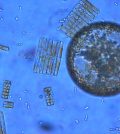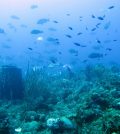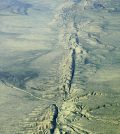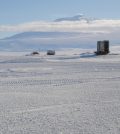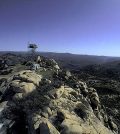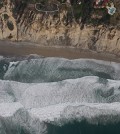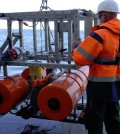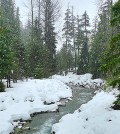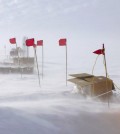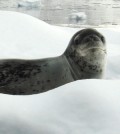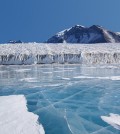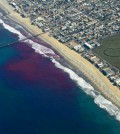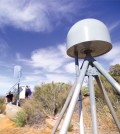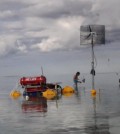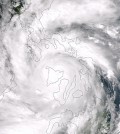Posts for tag "Scripps"
Ocean Acidification Disrupting Marine Food Webs
Using synthetic biology, researchers have identified a key biological mechanism in phytoplankton that is disrupted by ocean acidification.
- Posted April 11, 2018
Listening to Fish: How Sound May Help Us Identify and Study Life Underwater
A research team is learning how to listen to the sounds fish make with specially designed underwater camera rigs, enabling less invasive monitoring.
- Posted April 5, 2018
New Benthic Underwater Microscope Captures Coral Wars
A new benthic underwater microscope devised by scientists at Scripps Institution of Oceanography is capturing microscopic processes in the oceans.
- Posted October 24, 2016
San Andreas Fault’s Massive Uplift Areas Logged For First Time
Data from a GPS network help investigators document vertical uplift and subsidence of the San Andreas fault for the first time ever.
- Posted July 22, 2016
San Diego Beach Sand Study Finds Erosion Impacts
A study recently completed by scientists at Scripps Institution of Oceanography has measured erosion’s impacts on San Diego beach sand over the last seven winters. Erosion is a major concern when it comes to beach management, one...
- Posted July 12, 2016
Lake Whillans: Like Wetland, Fed By Ice Melt
A look at several research efforts that have yielded insights into the features of subglacial Lake Whillans in Antarctica.
- Posted June 8, 2016
Camera Networks Expanding To Keep Eye On Western Wildfires
A number of expanding camera networks across the U.S. West are key for tracking the beginning and spread of wildfires.
- Posted April 28, 2016
AlertSoCal Camera Network Aids Wildfire Prediction In Southern California
A network of mountaintop cameras, called the AlertSoCal system, operated by researchers at Scripps Institution of Oceanography offers a new opportunity for early detection of fire hazards in some of the most remote locations in Southern California,...
- Posted April 18, 2016
Desert Mangroves Make Surprisingly Good Carbon Sinks
Using core samples, mass spectrometry and other techniques, researchers explore the extraordinary carbon sink capacity of desert mangroves.
- Posted April 12, 2016
Airborne Effort Surveys Southern California Beaches’ Response To El Niño
Scientists at Scripps Institution of Oceanography are creating a detailed survey of the elevations of Southern California beaches and cliffs in the midst of one of the strongest El Niño seasons of the last 60 years, according...
- Posted March 22, 2016
Ocean Methane Seeps Tracked With Acoustic Recorders
An effort led by Scripps Institution of Oceanography scientists relies on acoustic recording technology to better understand methane seeps in the ocean.
- Posted March 21, 2016
Atmospheric Rivers Linked To Melting Sierra Nevada Snowpack
A new study by NASA, Scripps Institution of Oceanography and other partners has found that in California’s Sierra Nevada, atmospheric river storms are two-and-a-half times more likely than other types of winter storms to result in destructive...
- Posted March 18, 2016
New Agreement Lets Scripps Researchers Use Private Yachts For Free
A new agreement between the International SeaKeepers Society and the Scripps Institution of Oceanography will allow researchers from the institution to use society members’ yachts as research vessels, according to a release from Scripps. The partnership will...
- Posted February 9, 2016
High Melt Rates On Ross Ice Shelf
Studying along Antarctica’s Ross Ice Shelf, scientists have found that the melt rate of the ice shelf is much higher than expected, according to a release from the Scripps Institution of Oceanography. The rate is about 25...
- Posted February 2, 2016
Crittercams Help Scripps Scientists Study Antarctic Leopard Seals
Using NatGeo Crittercams, scientists led by Scripps Institution of Oceanography gain a rare glimpse into the underwater world of leopard seals.
- Posted December 4, 2015
North Pacific Ocean Waves May Contribute To Ross Ice Shelf Shifts
A group of scientists has begun documenting the effects that ocean waves have on the stability of the Ross Ice Shelf.
- Posted November 6, 2015
Off California’s Imperial Beach, Scripps Scientists Lead Dye Tracking Effort
Researchers at Scripps Institution of Oceanography are tracking dye movements off California’s Imperial Beach to develop forecasts of contaminant transport.
- Posted October 7, 2015
GPS, Radar Data Detail April 2015 Nepal Earthquake
Using a GPS network and interferometric synthetic aperture radar (InSAR), an international team of researchers has modeled the 7.8-magnitude earthquake that struck Nepal in April 2015, according to a release from the Scripps Institution of Oceanography. Their...
- Posted August 24, 2015
Scripps Study Could Lead To Better Coral Bleaching Forecasts
A Scripps Institution of Oceanography study of a shallow coral reef flat near the Great Barrier Reef could improve forecasting of mass bleaching events.
- Posted June 22, 2015
Pacific typhoons may intensify with even moderate climate change
Researchers at the Scripps Institution of Oceanography have found that the strength and frequency of typhoons in the western Pacific Ocean may increase given even a moderate climate change scenario, according to a release. They predict the...
- Posted June 3, 2015


